Introduction
Camera make and model: Konica Revio KD-420Z (almost identical to Minolta Dimage G400)
Review camera serial number: 6649946
Average street price (6th April, 2004): UK£229, US$350, EU350
The Konica Revio KD-420Z is a smart looking, slimline, four megapixel compact digicam with a generous looking list of features. The 420Z is one of the last cameras that will bear the sole 'Konica' brand. All new models from the newly-merged Konica Minolta company will carry a combined Konica Minolta logo. The 420Z was born in the Konica side of the new family and is an evolution of a number of Konica Revio models from the last couple of years. But just confuse things, a Minolta-branded version of the 420Z is also available, known as the Dimage G400.
 If this Minolta Dimage G400 looks familiar, that's because it's a Konica Revio KD-420Z with a Minolta badge
If this Minolta Dimage G400 looks familiar, that's because it's a Konica Revio KD-420Z with a Minolta badge
Notable competitors include: Canon Digital Ixus 430, Olympus Mju 410, Casio QV-R41, Fujifilm FinePix F420, Pentax Optio S4, Samsung Digimax V4, Sony Cyber-shot DSC-P8, HP Photosmart R707.
 With the lens revealed you can see how physically small it is
General Features
With the lens revealed you can see how physically small it is
General Features
Basically, the 420Z has a very familiar specification, including a four megapixel (actually just over 4.2 million sensor pixels, but just under 3.9 million effective pixels) 1/2.5 CCD sensor and a 3x 34-102mm equivalent zoom range, with a maximum aperture of f/2.8 at the wide end and f/4.9 at the telephoto end of the zoom range. Both manual and fully automatic exposure controls are available to the user.
A rechargeable lithium ion battery powers the 420Z and a separate charger unit is supplied so you can use the camera with one battery while charging an extra (optional) battery if required.
Movie recording, with sound, is possible in Motion JPEG/AVI format, though only at Quarter VGA (QVGA 320x240) resolution.
ISO speeds can be manually selected between 50 and 400. There are several auto exposure modes designed to work optimally in certain conditions, including: Portrait, Landscape, Nightscape, Snap, Sports and Angel the last being a mode to enhance skin tones.
 The 420Z has a distinctive and stylish design even with the sliding lens protector closed
Special Features
The 420Z has a distinctive and stylish design even with the sliding lens protector closed
Special Features
What makes the 420Z stand out from what is quite a big crowd? The main feature that Konica waves its big flag for is ultra-fast power up and power down times. Slide the front panel lens protector to the right and the lens emerges as if it's spring loaded and the electronics aren't far behind. You simply don't have to wait.
The DSP (digital signal processor) that contributes to the power on speed of the 420Z also boosts the performance of the autofocus system and the camera's shot to shot speed.
It's a similar story when you want to switch off slide the cover towards the lens, the lens retracts with indecent haste and you can close the cover all the way home almost immediately.
Another particular feature of the 420Z is its smart steel clad design that is slim enough, when the lens is retracted, to fit into a shirt pocket. Certainly distinctive is a bright blue LED that shines when the camera is switched on. However, it doesn't appear to serve any other purpose.
 Both SD cards (above) and Sony Memory stick cards can be used in selected Konica Revio models like the 420Z
Both SD cards (above) and Sony Memory stick cards can be used in selected Konica Revio models like the 420Z
A lot of cameras in the same class as the 420Z use SD memory cards and the 420Z is no exception. However, the 420Z continues Konica's policy of endowing selected Revio models with both an SD card slot and a Sony Memory stick compatible slot as well.
Notable features missing
There are a few things that some of the 420Z's competitors offer that the 420Z doesn't. These include low light AF-assist illumination, exposure histogram, best shot selection mode, blur warning, a pixel mapping mode to map out hot or stick CCD pixels, an audio/video out port to watch any movies on TV you have taken using the 420Z you need to use a separate memory card TV player or simply watch them on a PC.
Controls and design
 Innovation
Innovation
 The 'cross'-style arrangement of menus
The 'cross'-style arrangement of menus
Click
here for more examples of 420Z status and menu screens.
The main innovative feature of the Konica Revio KD-420-Z is its fast start up and power down speed. The theme of the layout of the main external controls on the back of the camera, with a cross-shaped arrangements of buttons centring on the navigation pad (see below) is also repeated in the menu system (above).
Build Quality
An impression of high quality and robustness is immediately apparent when you pick up a 420Z. It has a solid metal-finished feel about it and all the plastic mouldings are of high quality and fit well.
Controls
 1.Sliding lens cover/power switch, 2.Autofocus sensors, 3. Blue LED, 4.Flash unit, 5.Optical viewfinder, 6. Microphone, 7. Self-timer LED, 8. Lens, 9. Strap lug.
1.Sliding lens cover/power switch, 2.Autofocus sensors, 3. Blue LED, 4.Flash unit, 5.Optical viewfinder, 6. Microphone, 7. Self-timer LED, 8. Lens, 9. Strap lug.
 1. Colour LCD viewscreen monitor, 2. Optical viewfinder, 3. Play button, 4. Delete button, 5, Menu navigation paddle and close focus/flash control, 6. Shutter release button, 7, lens and image review zoom buttons, 8. Shooting and setup mode button, 9. Menu button, 10. Viewscreen monitor on/off and menu set button, 11. Battery and memory card bay cover.
Design
1. Colour LCD viewscreen monitor, 2. Optical viewfinder, 3. Play button, 4. Delete button, 5, Menu navigation paddle and close focus/flash control, 6. Shutter release button, 7, lens and image review zoom buttons, 8. Shooting and setup mode button, 9. Menu button, 10. Viewscreen monitor on/off and menu set button, 11. Battery and memory card bay cover.
Design
As can be seen below, the 420Z appears to have good looks as well as some thoughtful form and function.
 All the main controls are within reach of the user's thumb while the optical viewfinder is ideally off-set to the left
All the main controls are within reach of the user's thumb while the optical viewfinder is ideally off-set to the left
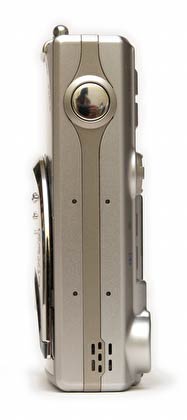 As seen from the top, the slimline aspect of the 420Z is clear
As seen from the top, the slimline aspect of the 420Z is clear
 The baseplate of the 420Z shows that the tripod socket has been located away from the battery and memory card compartment
The baseplate of the 420Z shows that the tripod socket has been located away from the battery and memory card compartment
 The only external connection is via a USB port
The only external connection is via a USB port
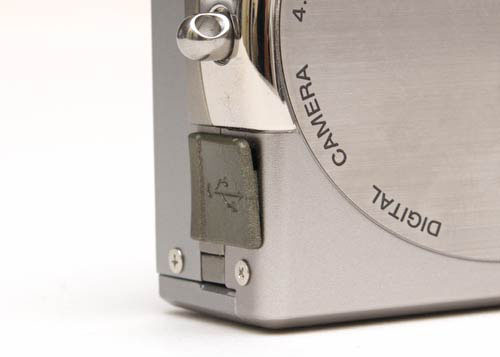 The USB port is protected via an ill-fitting flexible plastic flap
The USB port is protected via an ill-fitting flexible plastic flap
 The door on the baseplate reveals the lithium ion battery compartment and two memory card slots stacked on top of each other
The door on the baseplate reveals the lithium ion battery compartment and two memory card slots stacked on top of each other
 The top card slot seen occupied here is for SD cards and immediately underneath is the memory stick slot
The top card slot seen occupied here is for SD cards and immediately underneath is the memory stick slot
 A battery charger unit is provided and the proprietary lithium ion battery proved to provide a generous amount of capacity
A battery charger unit is provided and the proprietary lithium ion battery proved to provide a generous amount of capacity
 This shows that zooming between full wide and full telephoto only results in minimal additional extension of the lens
This shows that zooming between full wide and full telephoto only results in minimal additional extension of the lens
 Above shows the full extent of the 420Z's 3x zoom range
Above shows the full extent of the 420Z's 3x zoom range


Example menu, status and display screens
Below is an collection of screens, in no particular order, that a Konica Revio KD-420Z user will see and navigate.
The menu system uses series of colour coded levels. Once a level has been selected you can navigate from left to right and then, where necessary, up and down on the same level.
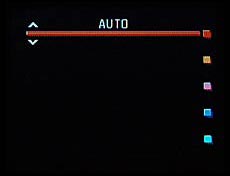
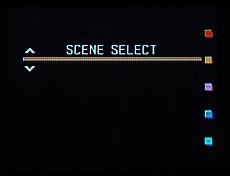




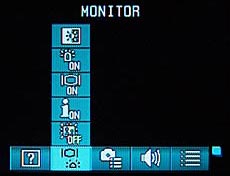
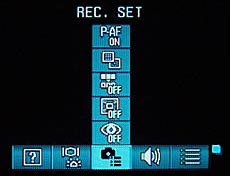











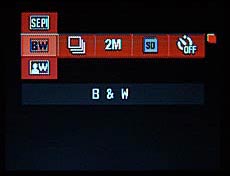












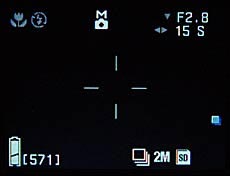


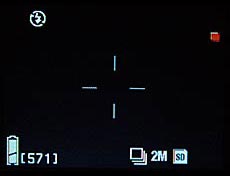
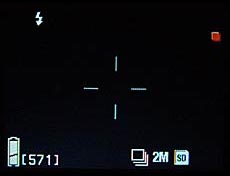







Ease of use
Settings

The 420Z has a reasonable number of external settings controls but in reality most settings, apart from close focus and flash modes, need to be menu-selected.
Status information
All status information is displayed on the 1.5 inch colour LCD viewscreen monitor. Different set up modes are colour coded and are selected using the mode button.



 In set up mode you choose the colour coded category, also distinguished by its vertical position on the screen. Once selected, you can navigate left and right to choose a particular setting and then up and down for the value you require
In set up mode you choose the colour coded category, also distinguished by its vertical position on the screen. Once selected, you can navigate left and right to choose a particular setting and then up and down for the value you require

 On the left above is an example of the view in playback mode and to the right and example of the status display in shooting mode
On the left above is an example of the view in playback mode and to the right and example of the status display in shooting mode
Click
here for more examples of 420Z status and menu screens.
Speed of operation
This category is the strongpoint of the 420Z. It takes under a second to be ready to shoot once you have slid the lens cover to the right and ditto for turning the camera off, once more. AF speed is also reassuringly swift for a camera of this class.
Two continuous shooting modes are offered by the 420Z: an 'infinite' mode only limited by the amount of memory available in your card and a faster burst mode. The former shoots at just over a second per frame or about 8 frames in 12 seconds, for example. The faster burst mode shoots three pictures in about 2.5 seconds. Shot to shot single shooting is generally un-hindered by waits.
Handling
The 420Z is a nice camera to hold for its class. Despite its slim design, it is easy to grip. If you need to use the optical finder, it's well sited to the left to avoid 'nose-squash'. The navigator pad operates well, as do the buttons radiating from it. The sliding lens cover is not to everyone'e preference and I did find myself leaving the lens exposed occasionally as the camera can be switched off without the lens being fully covered. But this is something that most cameras with a lens cover switch of this type are vulnerable to.
Focus
Autofocus performance of the 420Z is very good, being both quick for a camera of this class and usually accurate, with little hunting in normal conditions. There is no low light AF assist light, but this didn't seem to be a major problem.
Zoom
Like the rest of the camera, the zoom performance was quick for a camera of this type. As the zooming motor is stepped, there is limited fine adjustment for critical framing, an issue that also affects many other cameras at this level.
Flash
The flash performance of the 420Z is average for its class. It did a reasonable job illuminating subjects under medium to low indoor lighting and the red-eye reduction mode did its job. Flash brightness can be selected by the user in a manual custom mode and it's also possible to set a slow shutter speed for use with flash in order to brighten up the background of a flash-illuminated scene.

 Image quality
Image quality
 Framing accuracy
Framing accuracy
 The pink area shows the extent to which the LCD viewscreen monitor displays the scene and the surrounding blue and black areas are unseen and so wasted
The pink area shows the extent to which the LCD viewscreen monitor displays the scene and the surrounding blue and black areas are unseen and so wasted
In best resolution mode the recorded resolution is 2272x1704 or 3,871,488 pixels. The above image shows that actual useful coverage is 2194x1650 or 3,620,100 pixels, meaning 250,000 pixels or so are wasted, making the actual coverage about 93.5%, with 6.5% wastage and this is about typical for the class.
Colour

The picture above was taken at almost noon under the light of a December sun. Winter sun is naturally warmer than mid-summer sunshine, but the natural warmth of the 420Z has accentuated the richness of tone here.
Gretag Macbeth DC Color Chart
 Konica Revio KD-420Z
Konica Revio KD-420Z
 Olympus Mju:400
Olympus Mju:400
Above is a simple comparison of shots of a Gretag Macbeth ColorChecker DC chart taken with the 420Z (top) and an Olympus Mju:400.
The Mju:400 is one of the better cameras in this class with regard to colour reproduction. The 420Z, by comparison, shows a tendency to over-saturation and warmth that is typical of many consumer cameras. It's not necessarily a bad thing if you are mainly taking holiday and family snaps as it does make the pictures more attractive.
Fluorescent colours

DayGlo fluorescent colours are very difficult to reproduce well, photographically using digital or film methods. The 420Z hasn't really managed to capture the true appearance of our fluorescent card test here. The yellow looks quite muddy and the green looks too yellow.
Nature

It can't be said that the 420Z's over-saturated and warm colour characteristics result in accurate reproduction of natural colours like the green of the leaves above or the orange in the berries, but this bias is preferable to a cold or blue-ish alternative shown by some cameras.
Exposure metering

In the scene above the metering system has done a good job of disregarding the dark margins of the scene and exposed correctly for the central area of the scene seen through the bridge.

However, in the second scene above, the sky has caused the metering system to underexpose the mid and foreground areas of the picture.
Overall, the 420Z's metering performance is about average of its class it gets undemanding scenes right, works well when the central area is surrounded by dark areas but can be fooled by bright skies. This is typical of a centre-weighted metering system, which the 420Z uses. A smarter matrix mode metering system should be less prone to mistakes. A tighter central spot zone meter mode is available.
White balance
Once again, the typically warm balance of the camera in general is evident here. It was not easy to get neutral or cool whites under any lighting conditions. This can be corrected out of the camera of course, but the 420Z's performance was really only average in this respect.
Sharpness
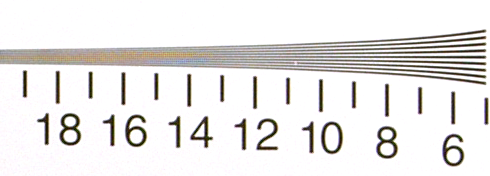 Konica Revio KD-420Z f/3.8 60mm (equiv) zoom
Konica Revio KD-420Z f/3.8 60mm (equiv) zoom
 Olympus Mju:400 f/4 60mm (equiv) zoom
Olympus Mju:400 f/4 60mm (equiv) zoom
 Konica Revio KD-420Z f/6.4 60mm (equiv) zoom
Konica Revio KD-420Z f/6.4 60mm (equiv) zoom
The ISO resolution test target shows that compared to the Olympus Mju:400 at around f/4 with the zoom set to an equivalent setting of 60mm, there is a similar performance. The 420Z result looks less sharp because the camera appears not to sharpen the image as much as the Mju:400 does.
Resolution suffers when the aperture is reduced to f/6.4 on the 420Z, which may explain why there are only two aperture settings available at any one time.
Noise
Noise was never perceived as a noticeable problem with the 420Z unless manually switching to the higher ISO settings. The low noise performance can be explained through the high efficiency of the camera's DSP image processor and the relatively modest amount of in-camera sharpening.
Fringing

Very good marks are scored by the 420Z when it comes to resistance to purple fringing. Above is a 1:1 reproduction of the corner of a frame that, with some other cameras, would show noticeable blue or purple halos along the high contrast edges of the branches. With the 420Z we can see it is practically non-existent.
Lens flare

As this almost head-on shot into the sun shows, the 420Z's lens does quite a good job of suppressing flare.
Distortion
 Konica Revio KD-420Z widest zoom setting
Konica Revio KD-420Z widest zoom setting
 Konica Revio KD-420Z mid-zoom setting
Konica Revio KD-420Z mid-zoom setting
 Konica Revio KD-420Z full tele zoom setting
Konica Revio KD-420Z full tele zoom setting
Here we have another very good performance from the 420Z. At the widest zoom setting, barrel distortion is well-controlled and almost gone by the mid-zoom setting. At full telephoto there is only the tiniest amount of pinchushion distortion visible.
Close focus
 Konica Revio KD-420Z closest focus coverage at full telephoto zoom
Konica Revio KD-420Z closest focus coverage at full telephoto zoom
 Konica Revio KD-420Z closest focus coverage at widest zoom setting
Konica Revio KD-420Z closest focus coverage at widest zoom setting
Best close focus coverage is achieved with the 420Z using the wide angle end of the zoom, though the price paid is some barrel distortion bowing of the result.
Movie mode
The movie mode of the 420Z is nothing special, though it does record a mono sound track. Only a QVGA resolution mode is offered and the action is as jerky as you would expect from most cameras in this class.


Manufacturer's Specifications - Konica Revio KD-420Z
| Type |
Digital Camera with zoom lens |
| Effective pixels |
4.0 megapixels |
| Recording media |
SD Memory Card, Multimedia Card, Memory Stick |
|
Recording pixels 1)
(64 MB SD Memory Card) |
4 mega Fine (approx. 36 images)
4 mega Normal (approx. 72 images)
2 mega Normal (approx. 143 images)
VGA Normal (approx. 574 images) |
| Recording format |
Still images: JPEG (Exif ver. 2.2, DCF 2) compliant), DPOF 3)
support
Still image audio/ audio only: WAV format
Movies: AVI format Motion JPEG |
| CCD |
1/2.5-inch CCD, 2408 x 1758 pixels,
(total approx. 4.23 megapixels), primary colour filter |
| Lens |
F2.8-4.9, f=5.6-16.8 mm (6 groups, 7 elements)
(equivalent to 34-102 mm in 135 size camera) |
|
Focal adjustment
Light measurement |
TTL 5-point centre-weighted metering by CCD brightness video signals +
external passive, centre-weighted metering (fixed focal lengths 0.8m,
1.2m, 2.5m, infinity) |
| Exposure range |
Normal exposure: Wide angle 0.5m to infinity, telephoto 0.8 m to
infinity
Macro exposure: Wide angle 0.05m to infinity, telephoto 0.5 m to
infinity
Super macro exposure: 0.2m to 0.4m (telephoto only) |
| Focus |
Wide angle: F2.8/ F4.7 Telephoto: F4.9/ F8.3 |
| Shutter speed |
Still images: Approx 1 sec. to 1/2000 sec.
Manual exposure: Approx 15 sec. to 1/1000 sec.
(noise reduction available from 1/2 sec.)
Movie: Approx. 1/30 sec. to 1/5000 sec. |
|
Camera-shake
Critical Speed 4) |
Slow Shutter OFF: Auto/Flash ON 1/60;
Flash OFF/ Nightscape Portrait 1/8
Slow Shutter ON: Auto/Flash ON 1/8, 1/15, 1/30, 1/60, 1/125;
Flash OFF/ Nightscape Portrait 1/1, 1/2, 1/4, 1/8, 1/15 |
| Exposure control |
Program AE (ISO100, 3 EV to 15.5 EV) |
| Exposure compensation |
±2.0 EV (0.3 EV steps) |
| Sensitivity |
ISO 100 equivalent, selectable sensitivity
(AUTO/ISO50/100/200/400) |
| White balance |
Auto compensation, manual settings possible
(Daylight, Cloudy, Incandescent, Fluorescent) |
| Finder |
True image zoom finder |
| Flash |
Built in flash, flash interval approx. 3.5 sec.
Range (AUTO sensitivity): Wide angle approx. 0.5m to 2.3m,
Telephoto approx. 0.8m to 1.3m
Green LED lights in finder during charging |
| Exposure modes |
Single / continuous / Flash ON / Flash OFF / Macro / Self-timer
(10sec., 3sec.) / Portrait / Landscape / Nightscape / Snap / Sports /
Angel / Movie (320 x 240 with sound) / B&W / Sepia / Red-eye Reduction
/ Digital Zoom (2x) / Program / Aperture Priority / Manual exposure /
Bracket |
| LCD monitor |
1.5-inch low-temperature polysilicon TFT colour LCD monitor with
backlit Brightness, Colours (Red, Green, Blue) adjustable |
| Playback |
Single image, index playback, slide show, digital zoom playback |
| Deletion |
Single image, specified image, all images, format |
| LED indicators |
Startup LED, Self-timer LED, Finder LED |
| Auto date |
Recording in year/month/date, or hour/minute until year 2050 5) |
| Power |
Lithium-ion battery (3.7V), dedicated AC adapter (optional) |
| I/O connector |
USB connector |
| Operating temperature
| 0°C to 50°C (humidity 20% to 80%)
|
| Dimensions (W/D/H) |
93.5 x 55.5 x 23 mm (excluding protrusions) |
| Weight |
Approx. 145g (excluding battery, card) |
|
Supplied Accessories |
Lithium-ion Battery, Recharger, Power code, USB cable, CD-ROM, Strap,
SD Memory Card |
Performance according to KonicaMinolta test conditions.
1) Number of recordable images varies with image content and card type.
2) DCF is a standard intended primarily for simple interworking between digital cameras and related devices, formulated by JEITA. Abbreviation of "Design rule for Camera File system".
3) DPOF is a standard formulated by Canon, Kodak, Fuji Film, and Matsushita Electric, intended to record information such as images to print in memory media. Abbreviation of "Digital Print Order Format".
4) Velocity of Auto/ Flash On varies depending on the zooming ratio.
5) A manganese silicon-lithium battery is used to backup the date/ time recording. Replacement to the new battery (to be charged) for every 3~5 years is recommended.
●The SD logo is a registered trademark.
●Memory Stick is registered trademarks of Sony Corporation.


Conclusions
dpnow review ratings explained
Percentages and other number-based ratings can be interpreted very widely by different reviewers and readers. This is why our rating system presents category-specific values in relation to a median. It's a bit like exam scores, where A or A+ is the best, C is the minimum pass and on to F, for failure. You can also see at a glance each rating value through a traffic-light colour code, with green for go - meaning good, amber or yellow for be cautious and red for stop. Click
here for further information about dpnow.com product ratings.
Features

Its very fast start up speed is the main feature of the Konica Revio KD-420Z. But it does also include full manual exposure control as well as auto exposure scene modes. In addition, there are some image effects modes and some limited custom functionality.
Design and construction

Quality materials and an attractive design make the 420Z stand out. The slimline steel-clad body looks like it will stand the test of time well, while the lens is well-protected by the sliding cover that doubles as the on/off switch. The arrangement of buttons on the back panel is both logical and stylish and shares a functional theme with the unusual menu system too.
Handling and ease of use

In most areas, the 420Z is an easy camera to get up and running with. Being quite a small and slim design doesn't detract from general ease of use as most of the controls are logically placed. The camera is also responsive, with few situations arising where you have to wait for the camera. If there is a weakness, it's that some settings are hidden away inside the menu system and there is no video-out port for connection to a TV.
Image quality

The 420Z has an excellent lens and, apart from an over-warm colour balance, resolution, control of flare and high contrast fringing are all very good.
Speed of operation

The 420Z is one of the fastest cameras in its class. It powers up and down very quickly, while the shot to shot and continuous shooting rates are very good for a camera of this class. And none of this is at the expense of noisy mechanics the camera proved to be refined and quiet in normal operation.
Autofocus

There were no undue complaints about the AF system in general use. In very dark conditions the lack of a focus assist light was telling, but in moderately dark conditions the AF system seemed to cope surprisingly well.
Value for money

If you shop around, the Konica Revio KD-420Z, or the nearly identical Minolta Dimage G400, can be found at very competitive prices compared to its obvious competition.
Things we liked about the Konica Revio KD-420Z:
Speed of operation
Design and build quality
Continuous shooting modes
General image quality
Compact and slim dimensions
Versatility of dual SD and Memory stick compatibility
Things we didn't like:
Over-warm colour balance
Lack of video-out port
Some functions buried by menu system
Very basic movie mode
Last words
It's easy to like the Konica Revio KD-420Z it's stylish, well made and works well. The over-warm colour balance of results can be easily fixed if necessary. If you are looking for a pocketable camera with a good range of creative control facilities, the 420Z, or its Minolta Dimage G400 sibling, can be heartily recommended.
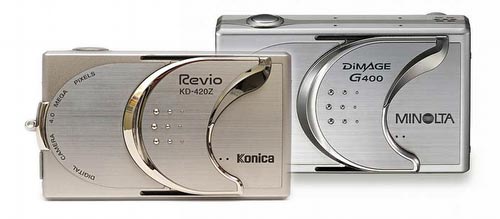 Buy your camera through dpnow affiliate partners
Buy your camera through dpnow affiliate partners
Our affiliate partners, Amazon.co.uk and the Digital Camera Company, list either the Konica Revio KD-420Z or Minolta Dimage G400 version. If you purchase this camera from our partners via the links below, you will earn a commission that will be reinvested in this Web site.

The Digital Camera Co
Check the latest price or purchase this item via

|

| 
|  |
| Click on the flag that best relates to your location |
| The EU flag links to Amazon Germany, currently the only European Amazon outlet that supplies electronic goods like cameras priced in Euros. |
| Each Amazon outlet can ship to most countries in the world. |






